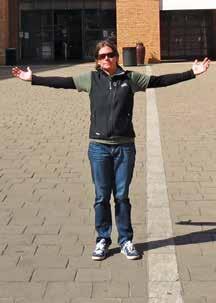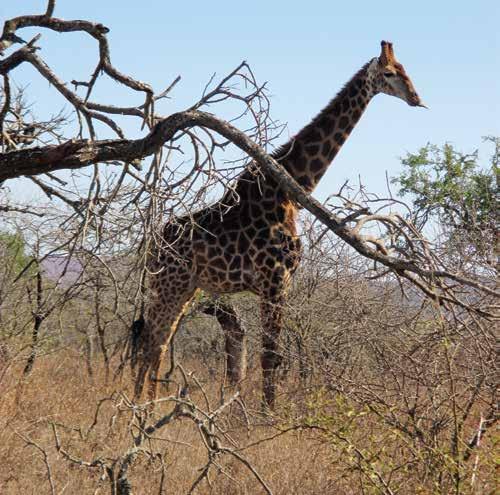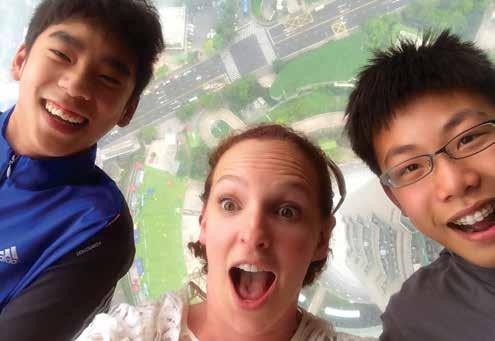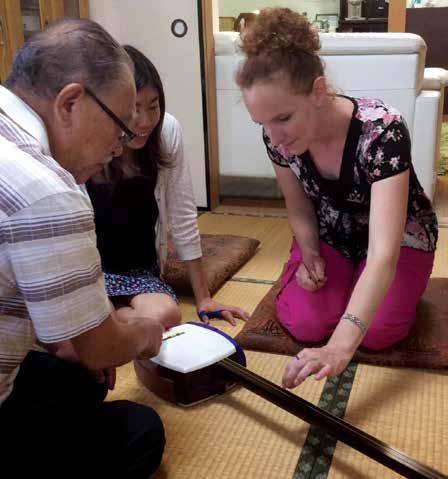
18 minute read
Faculty Adventures Thanks to the Ballantine Grant
Jen Buckley ENGLISH FACULTY O Disquiet in Africa In her application for the Ballantine Grant, English Faculty Jen Buckley wrote: “My interest in South Africa began as a child in the mid-late-1980s, when my father (himself an activist of the Civil Rights Era) explained apartheid to me and shared the music of Paul Simon and Ladysmith Black Mambazo with me. Ultimately, a trip to South Africa and neighboring Swaziland will enable me to learn more about the region, its complex (multicultural, colonial and postcolonial) history, its natural treasures, its arts, and its literature—all, hopefully, leading me to discover new voices, writers and works to bring into the freshman program…I would welcome the opportunity to travel to South Africa—my lifelong nation of study and interest— as a recipient of the 2014 Ballantine Grant.” FACULTY ADVENTURES THANKS TO THE BALLANTINE GRANT Through the generosity of former trustee Morley Ballantine P ’64, ’68, GP ’05, ’05 and her family, the Ballantine Grant supports faculty pursuits of independent study travel outside of Colorado and typically abroad. The goal of the grant is to enable faculty members to create and carry out a project of significant professional and personal interest, one that will contribute to the enrichment of the FVS program in general and to the growth of FVS faculty members in particular. ver the nearly three weeks that I spent in South Africa, I experienced many interesting, thought-provoking and inspiring sights, and engaged in several political conversations. But my most memorable experiences are two: driving down the N3 to the south out of Johannesburg and walking in the port city of Durban. Each of these experiences forced me to question uncomfortable things about the world and also about myself, questions that caused me to lie awake at night while in country and still cause me to lose sleep back in the United States. Driving from Johannesburg to the coastal city of Durban on the N3 takes approximately six hours. Sights along the way include some fairly predictable (or so I learned) African sights: shantytowns near the side of the road, which are literally tin shacks where several generations of a family and their livestock reside; seemingly hundreds (if not thousands) of black Africans hitchhiking, looking for rides to school or work or family—many of them shoeless children; women selling fruit and crafts by the roadside, sometimes approaching stopped cars to do so; piles upon piles of garbage—much of it burning; and, of course, monkeys. However, what I was unprepared to see was the juxtaposition of poverty with wealth. The poverty I viewed was comprised of the shacks upon shacks «
near the highway and also (what seemed to be) entire communities of women, on a calm Sunday morning, carrying buckets and looking for water. These women were walking miles to some stagnant water pools in the hopes of doing laundry or bathing their children that day. And all of this squalor was contrasted by millions of acres of irrigated sugar cane fields. I was shocked and horrified by this colonial-looking situation: African citizens spending an entire Sunday searching for and walking to water, while agri-businesses (some of which were less than a half-mile from shacks and stagnant water pools) needlessly, thoughtlessly (almost tauntingly, even) sprayed thousands of gallons of water onto sugar cane. The fields were pristine, green and shiny—shiny from sunlight reflecting off of the droplets of precious, clean water.
The first time I turned the corner and glanced upon these fields and massive irrigation systems, I was quite literally speechless. I had just driven for hours past scene after scene of immense poverty (and poverty further exacerbated by brown, dry land), turned a corner on the motorway, then watched as someone, somewhere was making money—presumably millions—off of the same land, through spraying water onto some plants. Even though I teach postcolonial literature and have traveled to the former British colonies of Ireland and New Zealand, these scenes, viewed quickly yet repeatedly, through the dirty windscreen of my rental car, were my very first encounters with the truly staggering wealth gap created in other formerly colonized lands like South Africa.
Once I adjusted to the shock of seeing such inequality, I found myself ruminating, then questioning the way that locals must view the irrigation. With anger? Outrage? Sadness, or worse, resignation? Unfortunately, I did not get to talk with a rural, local South African about the cane industry, so this question still plagues my mind, unanswered to this day. More troubling to me than these scenes of the wealth gap in that nation were my own psychological reactions to walking around the overcrowded city streets of Johannesburg and Durban. On my first day in country, I exited a taxi into downtown JoBurg. Instantly, I was overwhelmed and overpowered by the massive amounts of garbage everywhere. Food containers, papers, used and dirty clothing, plastic bags, and many unrecognizable things littered nearly every street corner of this city. To be


honest, having been in New York about one month after 9-11 and seen city streets littered with paper and refuse after the fall of the Twin Towers, that’s what the blowing and stinking piles of Johannesburg litter reminded me of—an aftermath.
Shortly after trying to adjust to the amount of loose trash seemingly everywhere, I walked down a side street in an attempt to see Hamidia Mosque, the location where, in 1908, Mohandas Gandhi led a protest of 3000 Indian-born, SouthAfrican residents of the Christian, Hindu and Muslim faiths; at that site, the protesters burned “identity cards” that they were forced to carry as nonwhite residents of the region. Having just completed reading a biography of Gandhi’s work in South Africa, I was excited to make this first stop on my cultural and historical journey.
However, in turning into the neighborhood that housed the mosque, I was nearly stopped in my tracks, for the amount of unemployed and homeless men in the area, sleeping and drinking on the sidewalks, was staggering to me. As I tried to progress further, as I tried to overcome my fear, I could not. I did not see another woman, or another white person for blocks. I was clutching my handheld camera as tightly as I could, touching my mid-section to make sure my under-clothing money belt was secure, and glimpsing left and right behind the cover of dark sunglasses. All that I saw were forlorn, tired, hungry faces staring at me, possibly for transgressing into their section of town. I turned and headed back into central Jo-Burg as quickly as I could walk, while also retaining my composure, literally trying not to hyperventilate.
Day after day in Johannesburg, in touring the city, I had similar experiences with being the only Anglo face on a street and in a market, and the accompanying sensations of feeling like the “other.” In places I traveled, I was a definitely an outsider and clearly drew attention from locals, attention in the form of confused looks, stares, calls out from street vendors selling cheap Adidas products, and several questions on whether or not I was lost. In the three days that I spent in Johannesburg, I often walked in fear, since my Western guidebooks to the city all noted the high crime levels (crimes of rape and ATM theft most notably).

Interestingly though, when I arrived in Durban on the Southeast coast of the nation, I immediately felt safer and more relaxed when touring its streets. Durban is the largest seaport in Africa, the city known for great white sharks that swim off of the coastline, and the city near which Gandhi resided for much of his 20 years in South Africa. Gandhi was working in Durban because of the many citizens of British India who had migrated, initially to work the cane fields of the area, and who then established thriving businesses in the region. Even today, the city houses a large population of British and Indian descent. In fact, Durban contains the largest population of Indian people living in a city outside of India (about 30 percent of Durban’s 3.5 million residents identify as being of Indian descent). While there, I strolled through a large Muslim bazaar, the Oriental Bazaar, the Indian Market, the Victoria Street Market and Juma Musjid Mosque, the largest mosque in the Southern Hemisphere. Muslim prayer chants filled the streets, and citizens jostled and bargained for goods and services in every inch of the Indian quarter while I also shopped and toured. While walking in the busy city center, I asked several conservatively dressed Muslim men as well as Indian South Africans for directions and for where to purchase souvenirs. I was feeling very multicultural and excited to be in this bustling market area—truly a place outside of my normal, proverbial comfort zone.
I was feeling very multi-cultural and excited... truly a place outside of my normal, proverbial comfort zone.

owners of our bed and breakfast, and reading more on Durban, I came to learn that the crime rate in Durban— especially for pick-pocketing and other sorts of muggings—was much greater even than that in Johannesburg. In fact, several recent news articles discussed the street crime in Durban and that the crime had frightened tourists away.
I was surprised at myself for feeling so relaxed in this dangerous and crimeridden seaport city, then wondered… was I relaxed because, over the course of a week, I had acclimatized to South African cities, the garbage, the homelessness and the over-crowded sidewalks? Had I grown more used to being the only (or one of the only) white faces on inner-city streets? Or, the more dangerous consideration, having been raised in America and with American media my whole life, was I psychologically preconditioned to associate crime with black faces and to associate helpful service with those of Indian descent (and with noticeably more British accents)? Sadly, although I hate to admit this to myself and still struggle with this realization to this day, I think it was the latter. I truly think that I felt “safer” surrounded by those of Indian heritage from my interactions with Indian shopkeepers, hotel owners and restaurant proprietors in the United States. This is the thought, the lingering thought about my Ballantine trip to South Africa, that sticks with me, that pricks my conscience, that makes me lose sleep, that makes me question the ways I have been conditioned to view the world—and the thought that makes the whole experience worthwhile, valuable, life-altering. Sure, to this day, I still think about what it was like to be a racial minority in some neighborhoods, shops and restaurants over the two-week journey. Then I think about what it must feel like for some of our FVS students to be the only one (or one of a few) in our school community of their racial background or from their particular country of residence: do these members of our community feel like “others,” or outsiders at all? But primarily, when I think about my time in South Africa (or when I consider how to answer the frequently asked question, “Ms. Buckley, how was South Africa?”), I am deeply troubled by my own psychological state as conditioned by my American upbringing, deeply troubled by the fact that I felt safer surrounded by Indian South Africans than black South Africans, and I am ashamed.
The Kindness of Strangers

Kathleen Czop DIRECTOR OF ENGLISH AS A SECOND LANGUAGE
Before moving to Fountain Valley, I lived in two different developing countries for seven years. In many ways, my quality of life in Cambodia and Guinea depended on the “kindness of strangers.” I see much of my role as international student adviser at Fountain Valley as returning that kindness to others who find themselves in a new place. Without any hesitation, I have lived alone in a hut in Africa and slept in remote villages in South Asia. However, the idea of navigating the mega-cities of Eastern Asia has always intimidated me. These cities seemed too overwhelming to encounter without trusted guides. In being awarded the Ballantine Grant, I found the opportunity to finally visit these cultures and make a deeper connection with my students and their families.
Honoka Furuya ’16 and ESL Director Kathleen Czop at a traditional tea ceremony
n the past, I primarily traveled alone, relying on my wits, curiosity, capacity for awe and good humor to see me safely through. But last year, I put myself in my students’ hands and spent the month of June visiting students—both current and alumni—and their families in the cities of Shanghai and Hangzhou in China, Seoul in Korea, and Tokyo and Yokohama in Japan. I
I was touched and humbled by the thoughtfulness of these students and their families. I met five alumni and 17 current students and families during my month in Asia. It is a daunting task to attempt to put into words here the impressions and events of those 30 days.
24/7 Reid Zhou ’15 greeted me at the Pudong Airport in Shanghai with his mother. He was so worried that I wouldn’t be able to contact him upon arrival that he and his mother waited for me the entire eight hours my flight was delayed. Although we did not walk through the door of their high-rise apartment until 9:30 p.m., his father had cooked a meal for us so that my first meal in China would be prepared from home.
The first morning, I woke up early, ate “tofu brains” (yes, that’s the literal translation) for breakfast before heading out to the bank to change money—on a Sunday! If I 15
Fountain Valley School of Colorado China is a novelty and attracted some curiosity. It now seems likely that this will be the only generation to be limited to one child, as the policy is set to be relaxed in 2015. It has made for a unique mix of indulgence and pressure on this one-child generation.
Billy Gong ’17 (right), Jack Yuan ’16 and Czop were in Shanghai at the Oriental Pearl Tower. “On one of the top floors, there is a glass floor and we were laying on it,” said Czop. “So fun!”

had to summarize my experience of Shanghai, it would be “24/7.” “Whatever, whenever,” seems to be the motto of this modern city.
I fully relied on students to read for me, speak for me and plan for me. I never even had to decide what to eat. Delicious food appeared in front of me on giant lazy susans in crowded, joyfully noisy restaurants. Then, another student would materialize out of the chaos to be my next guide.
Jack Zhang ’16 and his mother took me to an old village maintained in its original style and architecture on the outskirts of Shanghai. I asked Jack’s mother how she chose the restaurant in an unfamiliar place, and she said something I heard over and over in China: “Go to the one with the longest line because it must be very good.”
Walking around Shanghai with Lisa ’13 and Wendy Wu ’16 was interesting by the mere fact that they are sisters. Being sisters in one-child
Gangnam Style
My next stop was Seoul, another city that seemed to have arisen overnight. My first impression was awe at the amount of cafes. Koreans love coffee; Seoul has the distinction of having the most Starbucks locations of any single city. My guide, Sang Jae Lee ’16, pointed out to me that the only institutions as plentiful as coffee shops in the Gangnam district are cosmetic surgery offices and English cram schools. The song “Gangnam Style” refers to this upscale neighborhood in Seoul, where incidentally, most of our Korean students live.
Immediately palpable was the feeling of urgency in Seoul. The pressure to conform to a relatively narrow definition of success and beauty drives this city and our students. It is common for Korean students to leave the house for school at 6:30 a.m., and not return until 10 p.m., after cram school and private lessons. There are millions of people competing for the same goals, which are essentially admission to an Ivy League school in the U.S. and a prestigious career in business, law or the medical profession.
The flip side to this pressure is an almost frantic pursuit to enjoy one’s self in rare moments of free time. Ethan Lee ’15’s mother told me that she feels she is missing out on something if she goes to bed before 3 a.m. On this particular day, she worked a full day, picked up Ethan at his SAT
study school, and then the three of us went to dinner and karaoke. I was stunned by the crowds out late on a Monday night. I marvel that these students are able to adapt to life at a school in the middle of a windswept prairie.
Japan, the land of the rising sun
My itinerary for Japan was almost entirely planned by students Honoka Furuya ’16, Koyo So ’17 and their mothers with a perfect blend of traditional and modern experiences.
In Tokyo, the girls and I had pictures taken in photo booths that are all the rage with Japanese teenage girls. Essentially mini-studios, they provide the surreal opportunity to have “beauty” sessions through photo editing software that makes the subjects whiter, taller, thinner and with rounder eyes. I tend to forget that not everyone has this experience. For example, I was a bit surprised when Honoka’s grandparents told me that I was the first American who had ever visited their home. Apparently, they had fretted quite a bit over this occasion. Honoka’s grandfather, a retired professional musician, had the visit planned literally down to the minute. He played his shamisen for me and then gave me a lesson. I was just barely getting the proper grip on the instrument when he announced it was time for a walking tour of the neighborhood. This was to be a brisk walk with limited time for me to admire the breathtaking flowers that even the smallest patio had artfully displayed. Next was the meal, where it seemed Honoka’s grandmother was intent on single-handedly ensuring that I ate the best food Japan had to offer.
Honoka’s mother arranged for Honoka and I to participate in a traditional tea ceremony dressed in elaborate kimonos. This was a novelty for Honoka as well, since the occasions for Japanese girls to wear traditional kimonos are typically limited to specific celebrations at the ages of 2, 7 and 20.
In all of the cities I visited in Asia, I was struck by how almost all of the socializing takes place outside of the home. I think this is due to the fact that the living spaces are generally much smaller than in America due to the overcrowding of the cities. It is very rare to invite a friend to the house for a meal, let alone to spend the night. This is one reason why Asian students at FVS are so impressed with their experiences being hosted by American families over holidays.

Since I spend the majority of my time with people from other countries, 17
Honoka’s grandfather giving a lesson on how to play the shamisen

In the car afterward, Honoka and I both fell asleep immediately, me because I was taking in so much information and striving to have impeccable manners, keenly aware that I was representing not only myself, but to some extent, all Americans. As I remind my students, we are all ambassadors. Honoka, on the other hand, was exhausted because she was not only translating into her second language, but attempting to accurately convey aspects of her Japanese culture and her Fountain Valley culture to her listeners. This is a struggle that all of our international students face. Throughout my trip, I gained renewed appreciation for what my students contend with as second language learners. I was reminded several times of the loneliness and frustration that can accompany those struggling with proficiency in a language, such as when I had no one to chuckle with at a sign at a hotel buffet in Shanghai announcing the “pancake and wolf station.” I guess that yes, in fact, the word “waffle” does sound like “wolf” when said quickly. Or when I confidently greeted Honoka’s mother one morning with one of the few Japanese phrases I know, “Oyasaminasai” (good night), and her mother laughed and cheerfully greeted back, “Ohayo gozaimasu” (good morning).
But even the most confusing moment in a different culture is a gift. I am so grateful that the Ballantine Grant gave me and my students the opportunity to challenge the traditional notion of the teacher/student dynamic, allowing them to be the guides and me to experience once again the feelings of vulnerability, trust and gratitude (and confusion and jet lag!) that accompany immersion in a foreign culture. This deepens my sense of empathy for what the international students experience on a daily basis at FVS and I believe, in turn, empowers those students to reflect on what they value about their own cultures.







